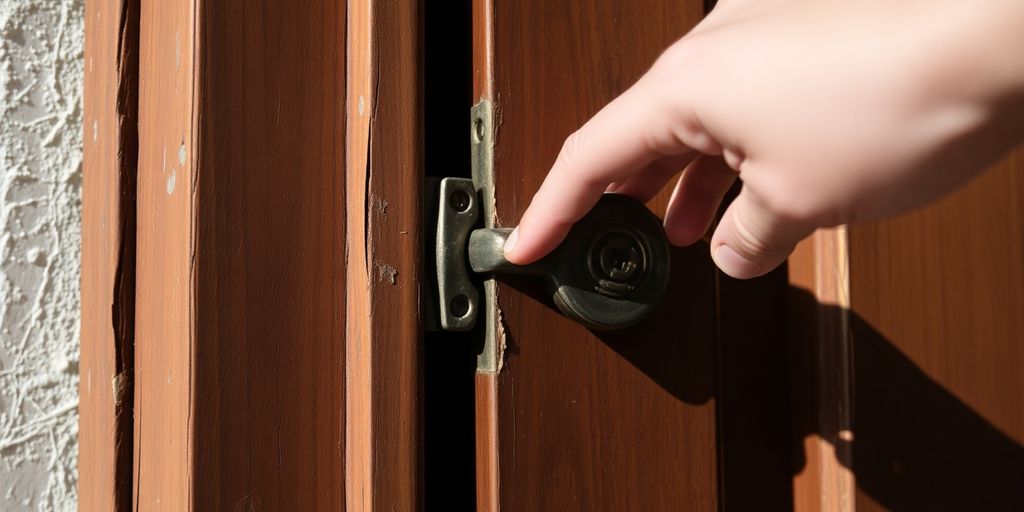
5 Effective Solutions for When Your Door Is Stuck: Tips to Resolve the Issue
We've all been there: you're in a hurry, and your door is stuck. It can be super frustrating, especially when you're trying to get out or get in. But don't worry—there are some simple tricks you can try to get that door moving again. In this article, we'll cover five effective solutions to help you deal with a stuck door. From lubricants to tools, we've got you covered with practical tips that can save you time and hassle.
Key Takeaways
- Use graphite lubricant to reduce friction in the lock mechanism.
- Compressed air can help clear out dirt and debris from the lock.
- Lock lubricant spray is great for maintaining smooth operation.
- A screwdriver set can assist in adjusting or removing the lock if needed.
- If all else fails, consider replacing the lock for a long-term solution.
1. Graphite Lubricant
Okay, so your door's stuck. Annoying, right? Before you go all Hulk on it, let's try something simple: graphite lubricant. I know, it sounds fancy, but it's basically just powdered graphite, and it works wonders on sticky locks.
Think of it like this: the inside of your lock is a tiny city, and the key is a car trying to navigate the streets. Over time, dirt and grime build up, causing traffic jams. Graphite lubricant is like a street sweeper, clearing the way for smooth movement. It's a dry lubricant, so it won't attract more gunk like oil-based stuff does.
Here's the deal:
- Grab some graphite lubricant. You can find it at most hardware stores. It usually comes in a small tube or puffer bottle.
- Insert the nozzle into the keyhole and give it a puff. Don't go crazy – a little goes a long way.
- Insert your key and gently wiggle it back and forth. This helps distribute the graphite throughout the lock mechanism.
- Remove the key and wipe off any excess graphite. You don't want to track that stuff all over your house.
- Try the door again. Hopefully, it's now cooperating. If not, move on to the next solution.
I had a door that was sticking for months. I tried everything – WD-40, silicone spray, even banging on it a little (don't judge). Nothing worked until I tried graphite lubricant. Seriously, it was like magic. The door opened like new, and I felt like a genius.
If you're dealing with a blocked myshopify.com access, this might not be the solution, but for a sticky lock, it's worth a shot!
2. Compressed Air
Sometimes, the issue isn't rust or gunk, but just plain old dirt and dust trapped inside the lock mechanism. This is where compressed air comes in handy. I've used this trick a few times, and it's surprisingly effective. You can pick up a can of compressed air at any hardware store, or even use the stuff you use to clean your computer.
Here's how I usually do it:
- Grab your can of compressed air and the little straw attachment.
- Stick the straw right into the keyhole as far as it'll go.
- Give it a few short bursts of air. Don't go crazy; you don't want to damage anything.
- Insert your key and try to wiggle it around a bit. This helps loosen any stubborn particles.
- Repeat the air blasts and key wiggling a couple of times.
The goal is to dislodge any loose debris that's preventing the lock from working smoothly. If you're lucky, this will clear the blockage and your key will turn like new. If not, don't worry, we've got more tricks up our sleeve. Just remember to wear eye protection; you don't want any of that dust flying into your eyes. Also, be mindful of the environment and avoid excessive spraying.
3. Lock Lubricant Spray

Okay, so sometimes the old graphite trick just doesn't cut it. That's when you need to bring out the big guns: lock lubricant spray. I had a stubborn lock on my shed last summer, and this stuff was a lifesaver. Seriously, I was about to call a locksmith, but I figured I'd give this a shot first. Glad I did!
- First, give the lock a good cleaning. You can use compressed air to blow out any loose dirt or debris.
- Next, aim the nozzle of the lubricant spray directly into the keyhole. Don't be shy, give it a good squirt.
- Insert your key and gently wiggle it back and forth. This helps the lubricant work its way into all the nooks and crannies of the locking mechanism.
- Wipe away any excess lubricant that drips out. You don't want that stuff attracting more dirt.
The key here is to use a lubricant specifically designed for locks. WD-40 might seem like a good idea, but it can actually attract more dirt and gunk over time, making the problem worse. Trust me, I learned that the hard way with my mailbox lock. Now it's all gummed up, and I have to use a special tool just to get my mail out. Don't be like me!
If the lock is still being stubborn, try repeating the process a few times. Sometimes it takes a little patience to get everything moving smoothly again. And if all else fails, well, there's always the next option on the list...
4. Screwdriver Set
Sometimes, the simplest tools are the most effective. A screwdriver set is invaluable when dealing with a stuck door, especially if the issue involves loose screws on the hinges, strike plate, or doorknob. I can't tell you how many times I've seen a door sticking just because a few screws weren't properly tightened.
Here's how a screwdriver set can help:
- Tightening Loose Screws: This is the most common use. Over time, screws can loosen due to regular use, causing the door to sag or the strike plate to misalign. A quick tightening can often resolve the problem.
- Adjusting the Strike Plate: The strike plate is the metal plate on the door frame where the door latch catches. If the door isn't closing properly, the strike plate might be misaligned. Loosening the screws, adjusting the plate, and then re-tightening them can fix this.
- Removing and Replacing Parts: If you need to remove the doorknob, lock mechanism, or hinges for inspection or replacement, a screwdriver set is essential. Make sure you have the right size and type of screwdriver (Phillips or flathead) to avoid stripping the screw heads.
Having a good quality screwdriver set is a must for any homeowner. It's not just for doors; you'll find yourself using it for all sorts of repairs around the house. Plus, it's way cheaper than calling a handyman for every little thing.
It's also worth noting that sometimes, the screws themselves might be damaged. If that's the case, you might need to replace them with new ones. A hardware store will have a variety of screw sizes and types to choose from. Just make sure you get the right ones for your door and hardware.
5. Replacement Lock

Sometimes, despite your best efforts, the lock is just beyond repair. Maybe it's old, damaged, or you just want an upgrade. Whatever the reason, replacing the lock might be the best solution. It's not as scary as it sounds, and it can seriously boost your home's security. I know, dealing with locks can be a pain, but sometimes it's necessary.
Consider this your last resort, but also a fresh start for your door's security.
Think of it like this:
- Is the lock super old? Time for an upgrade.
- Has it been repeatedly jamming? Save yourself the headache.
- Did someone try to break in? Definitely replace it.
Replacing a lock isn't just about fixing a problem; it's about peace of mind. Knowing your home is secure is worth the effort.
If you're not comfortable doing it yourself, call a locksmith. They can help you choose the right lock and install it properly. I had to do that once when I accidentally broke my key inside the lock. Total disaster, but the locksmith saved the day. Plus, they can offer advice on smart locks and other security features.
Wrapping It Up
So, there you have it! Dealing with a stuck door can be a real hassle, but it doesn't have to ruin your day. We’ve gone over some solid tips to help you troubleshoot and fix the problem. Whether it’s cleaning the lock, checking for misalignment, or knowing when to call in a pro, you’ve got options. Remember, regular maintenance can save you a lot of headaches down the road. If you keep an eye on your locks and take care of them, you’ll likely avoid these sticky situations in the future. Good luck, and may your doors swing open smoothly!
Frequently Asked Questions
What should I avoid doing if my key won't turn?
If your key isn't turning, don't try to force it. Forcing the key can break it or damage the lock more. It's better to check for visible issues first.
How can I fix a key that is stuck in the lock?
To fix a stuck key, try using a lubricant like graphite powder. Gently wiggle the key while pulling it out. If that doesn't work, you might need pliers to pull it out carefully.
How often should I check or replace my door locks?
It's a good idea to check your door locks at least once a year. Regular cleaning and lubrication can help them work better and last longer.
What causes a door lock to jam?
A door lock can jam due to dirt, misalignment, rust, or worn-out parts. Keeping the lock clean and well-aligned can help prevent jams.
Is it safe to try to fix a jammed lock myself?
Yes, you can try to fix a jammed lock yourself using simple tools and lubricants. However, if you're unsure or the problem persists, it's best to call a locksmith.
When should I consider replacing my door lock?
You should think about replacing your door lock if it's rusty, worn out, or if it frequently jams. A new lock can provide better security and peace of mind.
